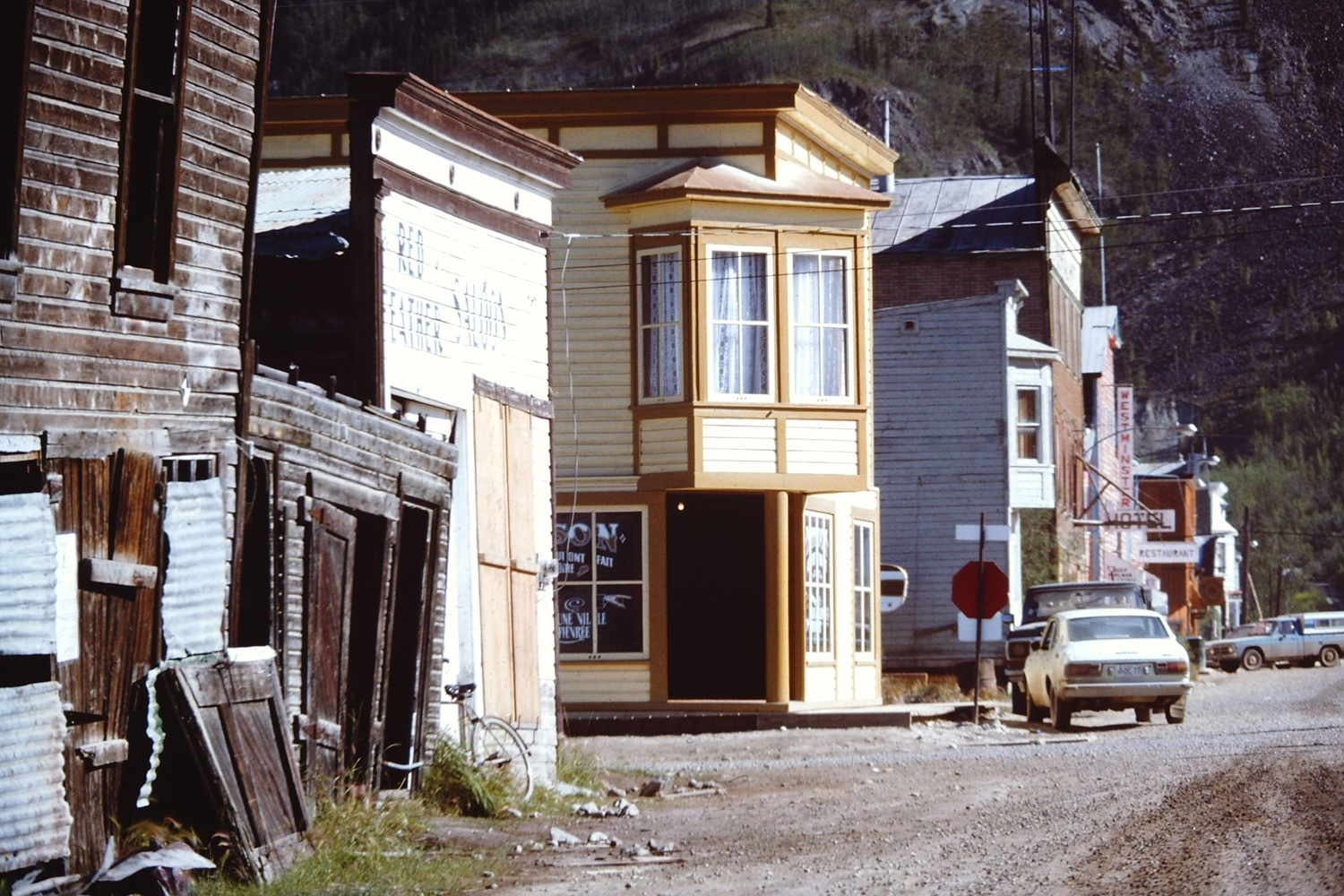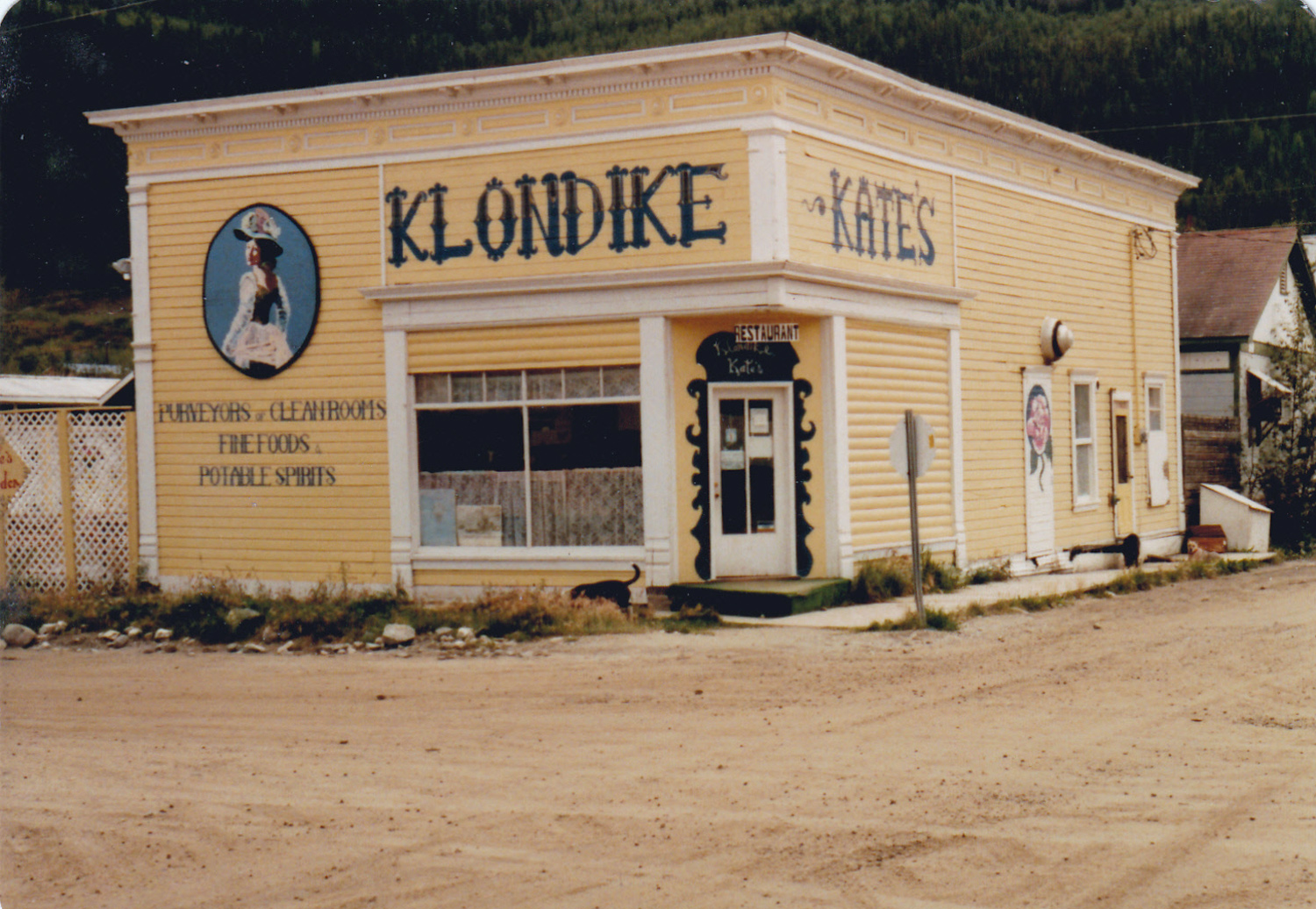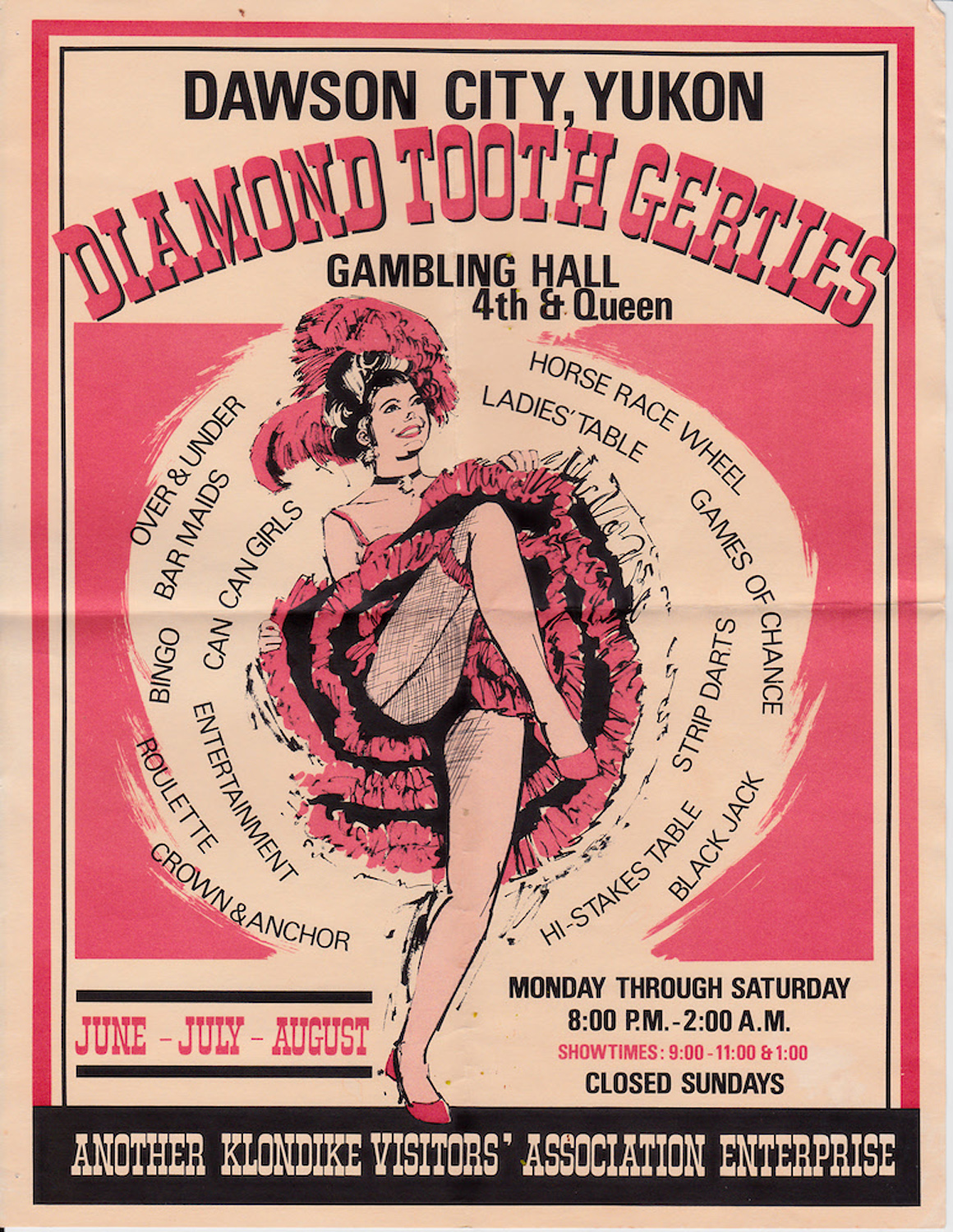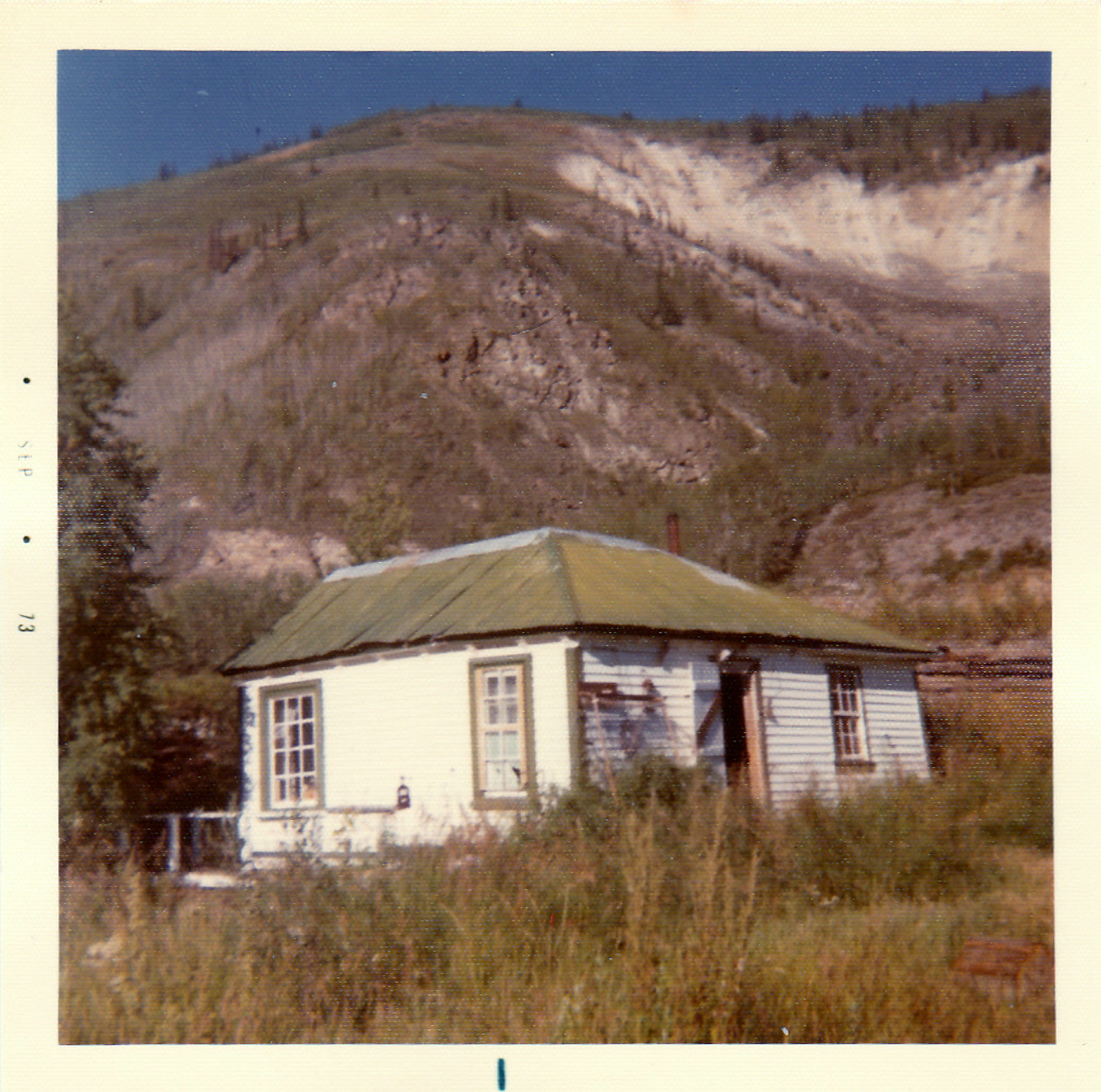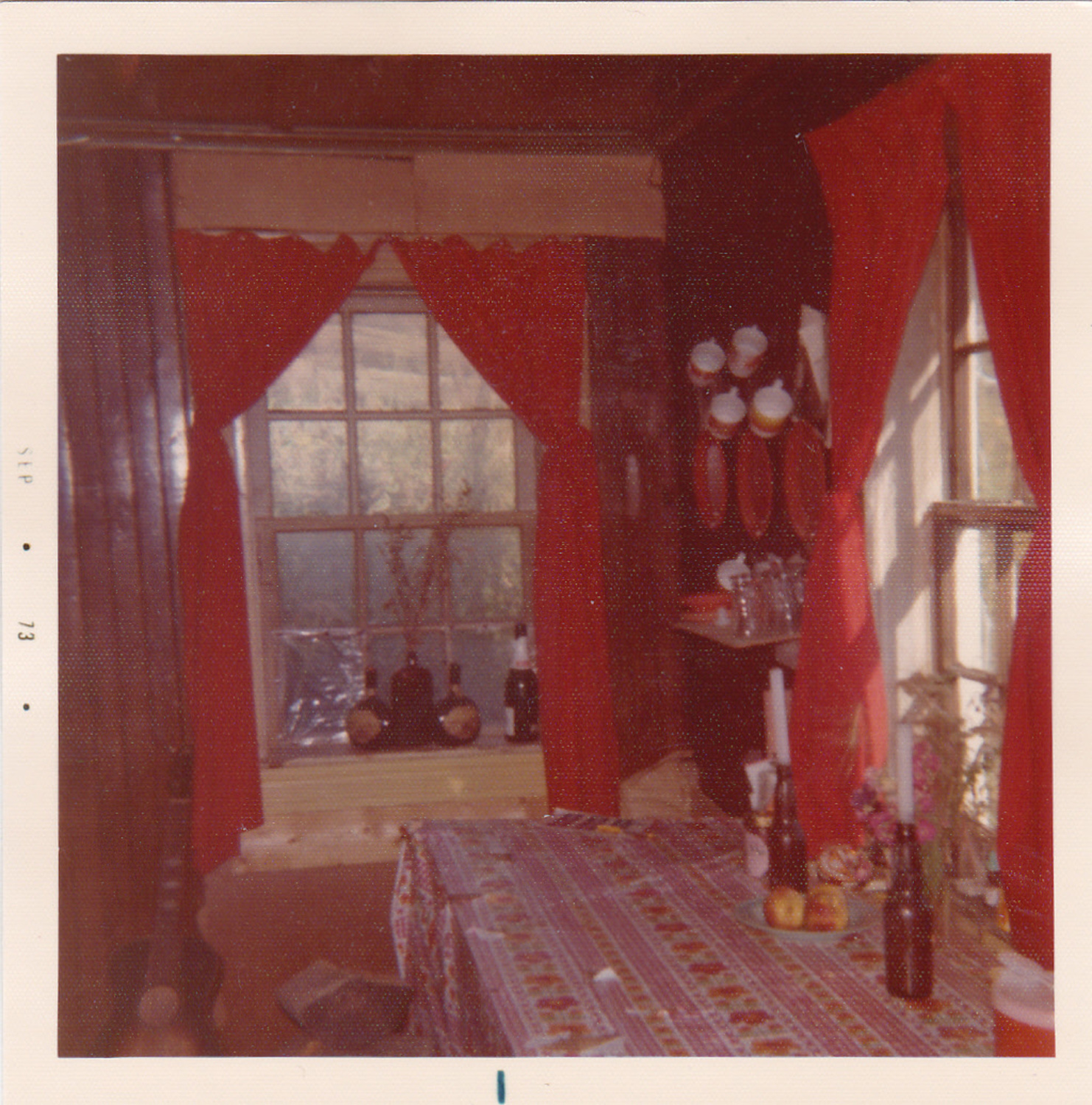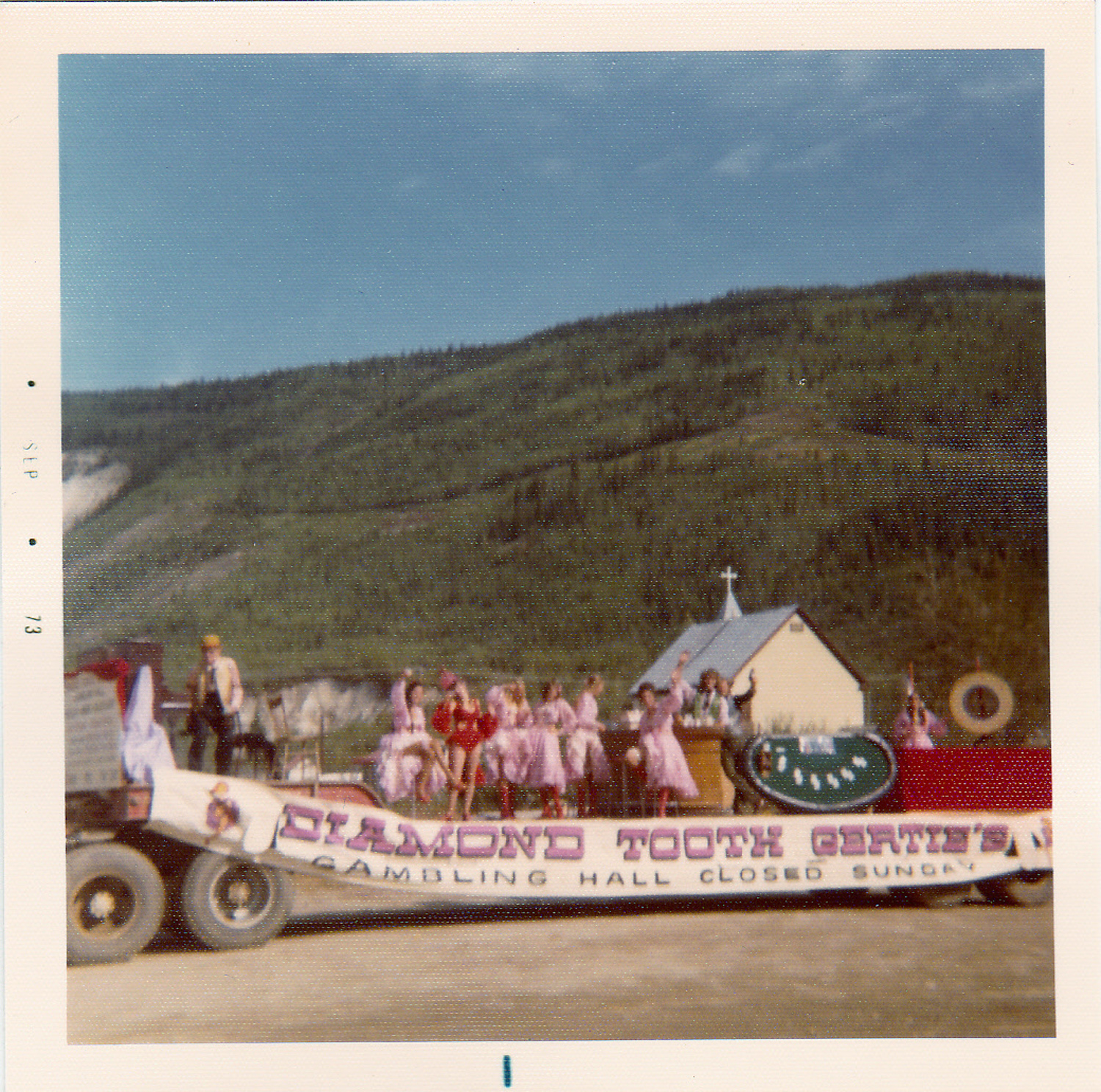A Yukon Summer In Dawson City
A story about Dawson in the 1970s, published exclusively online with accompanying photographs.
I was born and raised in Toronto, Ontario but always felt that I was in the wrong place, as I hate big cities. Going to Dawson City for the summer of 1973 was just what I was looking for! I never lived in Toronto again. Banff, Alberta and Vancouver, B.C. as well as Dawson City were my homes for periods of time. Then it was back to Ontario for marriage and raising my family, just west of Ottawa. Art has always been my interest and I started painting in my teens. As my children were growing, I took a watercolour course and started showing and selling my paintings in the eighties in galleries and art shops. I taught watercolours from 1994 till 2013, then I moved from the Ottawa area to Revelstoke, B.C. Now I paint mostly in acrylics and show and sell my paintings here. Recently, I switched from canvas to driftwood. I sell my driftwood paintings in Revelstoke at the Visitors Centre and the Railway Museum, as well as to people in Whitehorse and Dawson City.
When the pandemic started, I turned to writing. I answered the call from Karen Murray of the Klondike Visitors Association when she asked for memories from people who had worked in Diamond Tooth Gerties. Writing my memories was such a thrill that I became part of a local writer’s group and went on to write this story. When I joined the Dawson City Blast From the Past facebook site, I noticed how much people enjoyed my old photos from 1973 and 1978 so I included some of them in my story.
A Yukon Summer In Dawson City
by Donna Naprstek
In the summer of 1973, I was a cancan dancer at the only legal gambling house in Canada. My girlfriend and I had spent the winter skiing and working in gorgeous Banff, Alberta. We weren’t ready to go back to Ontario just yet and it was time for our next adventure. A fellow told me that he could get us jobs as cancan dancers for the summer in Dawson City. He claimed that mountains there glittered with gold! So we thought, why not give it a try? This rugged country is where writers like Jack London and Robert Service got their inspiration for their famous stories and poems about survival in the wilderness. Men and women were crazed by the lure of gold that was found in the Klondike River, Bonanza Creek and other tributaries.
We left Banff in early May and flew to Whitehorse, then took a bus to Dawson. It was a five hundred and thirty kilometer drive along the dusty Klondike Highway. Every time the bus stopped for breaks, a fellow with light brown hair driving a little VW bug stopped. Uri Naprstek was from Czechoslovakia and speaking English was difficult for him, which I found rather attractive. A summer job was taking him from Vancouver to Clinton Creek, north of Dawson.
After the long bus ride we got our first glimpse of the town. Log cabins and other wood houses spread out on the flat ground beside the Yukon River. The years had been good to some of the buildings but others were dilapidated, leaning at awkward angles, false fronts and all. A grand old, refurbished sternwheeler caught my eye. Beside this was the yellow and white building where Robert Service had worked as a bank clerk. I noticed boardwalks lining streets of dirt. The highway continued north, to the Canada / U.S. border, using a ferry to cross the river.

We arrived in Dawson in time for dinner. Uri joined us as we headed on over to the Downtown Hotel, a red and white building with swinging saloon doors. The first person we saw was the fellow who had told me about those cancan dancing jobs. He fidgeted on his bar stool and confessed that he couldn’t really get us jobs but he told us who to talk to for an interview. Next morning April Moi hired us even though we had no dance experience. All that was needed back then was to work hard, learn the songs and dances, and entertain tourists with dazzling smiles.
The show required six dancers and one leading lady acting as Diamond Tooth Gertie. Gertie Lovejoy was a dance hall girl in the early 1900’s. She lured many miners away from their hard-earned gold and had a diamond placed between her two front teeth. The hall that is named after her was built in 1901 by the Arctic Brotherhood, a group of Canadian and American gold rush adventurers.
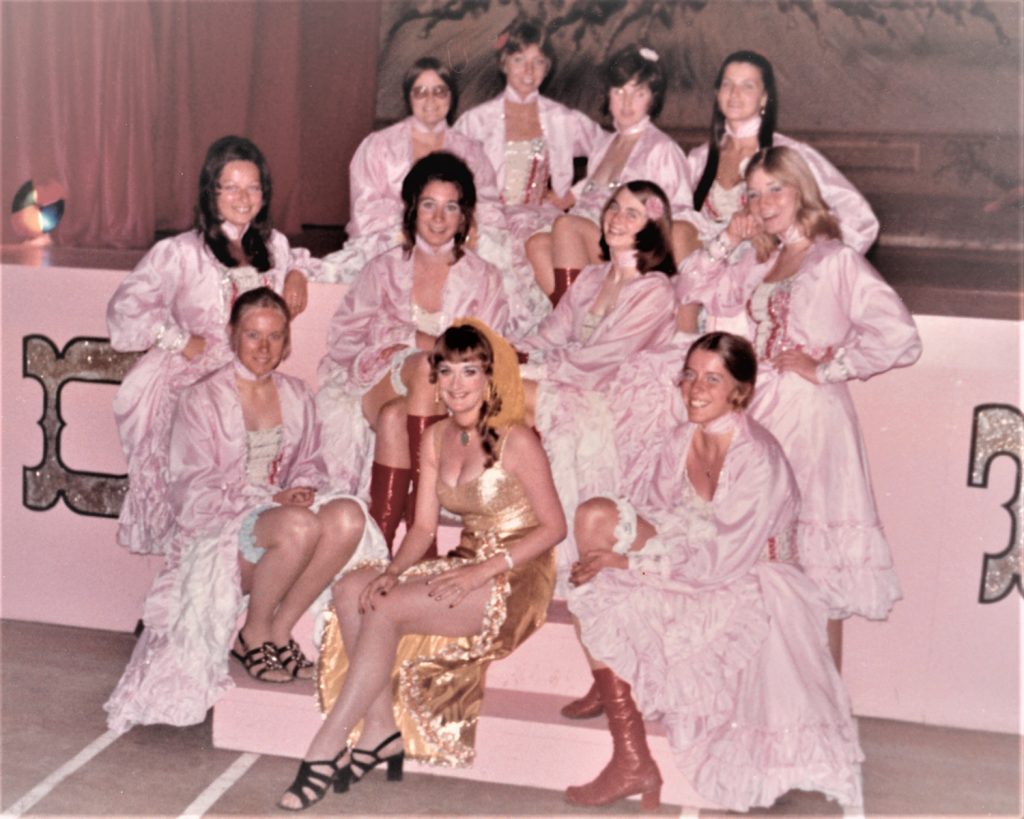
Our costumes were all pink and white. The full skirts had layers of crinoline and light jackets were worn over sequined tops. Three times a night we’d burst onto stage in a flurry of dances and songs, kicking our legs high in the air. The audience loved it when we threw our garters into the crowd. When we weren’t on stage, we were cocktail waitresses. This job was physically demanding and we all had broken blood vessels in our legs over the summer. Bruises were a sign of a job well done. That year, Diamond Tooth Gertie was played by Joyce Reddy who taught us to dance and sing while Fred Bass played the piano. Gambling tables were set back from the stage for those who wanted to test their luck.
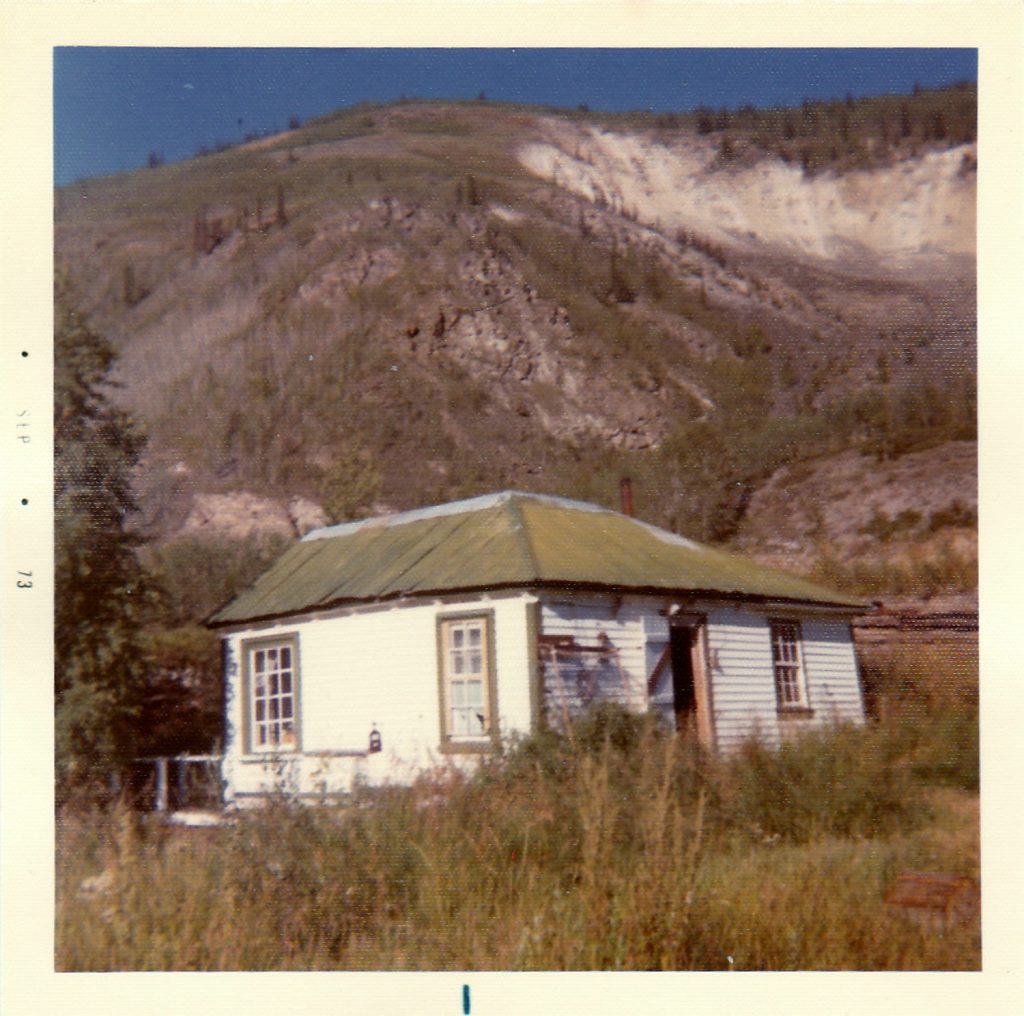
My friend and I ended up sharing a little white cabin with two guys that we met on the bus. The cabin sat on the edge of town, up on a hill, under the Moosehide Slide beside Father Judge’s grave. Father Judge was responsible for building Dawson’s first church and hospital in the gold rush days. According to the Dawson City museum, our cabin was actually the vestry part of his church. The rest of the church burned down in 1950. Father Judge was considered the Saint of Dawson when he provided shelter, food and medicine for miners working in the gold fields. Many of them became ill with scurvy, pneumonia, and frost bite. Jack London was suffering from scurvy and went to Father Judge’s hospital for care.
The Catholic Church rented the cabin to us for $25.00 a month. Incredible! But there was no electricity or running water and the cabin only came with a big comfortable arm chair, a couch and a bunk bed. The dump behind the cabin provided us with wood and stumps that we used for a table and stools. We also built an outhouse, but we didn’t bother with a door since we were on the edge of town. This gave us a great view of the Yukon River flowing by! Living in the land of the midnight sun meant that we didn’t need lights. We cooked on a Coleman stove. After a thorough cleaning, we bought material at Butterworth’s General Store and made curtains for the windows. A few shelves for dishes and we were done. So much happened that summer and because the sun shone almost all night, we barely took time to sleep!
The ice broke up on the Yukon River during the second week of May. Warm spring temperatures softened the ice and it broke apart with cracks and groans, allowing river water to flow more freely. We watched as huge pieces of ice were pushed up on shore or carried on downriver with a deafening rush. Ever since the gold rush days, bets have been made on the time and day of this remarkable event. An ounce of gold was the prize. When the ice started to move, a siren would sound. Everyone would leave what they were doing and rush to the river.
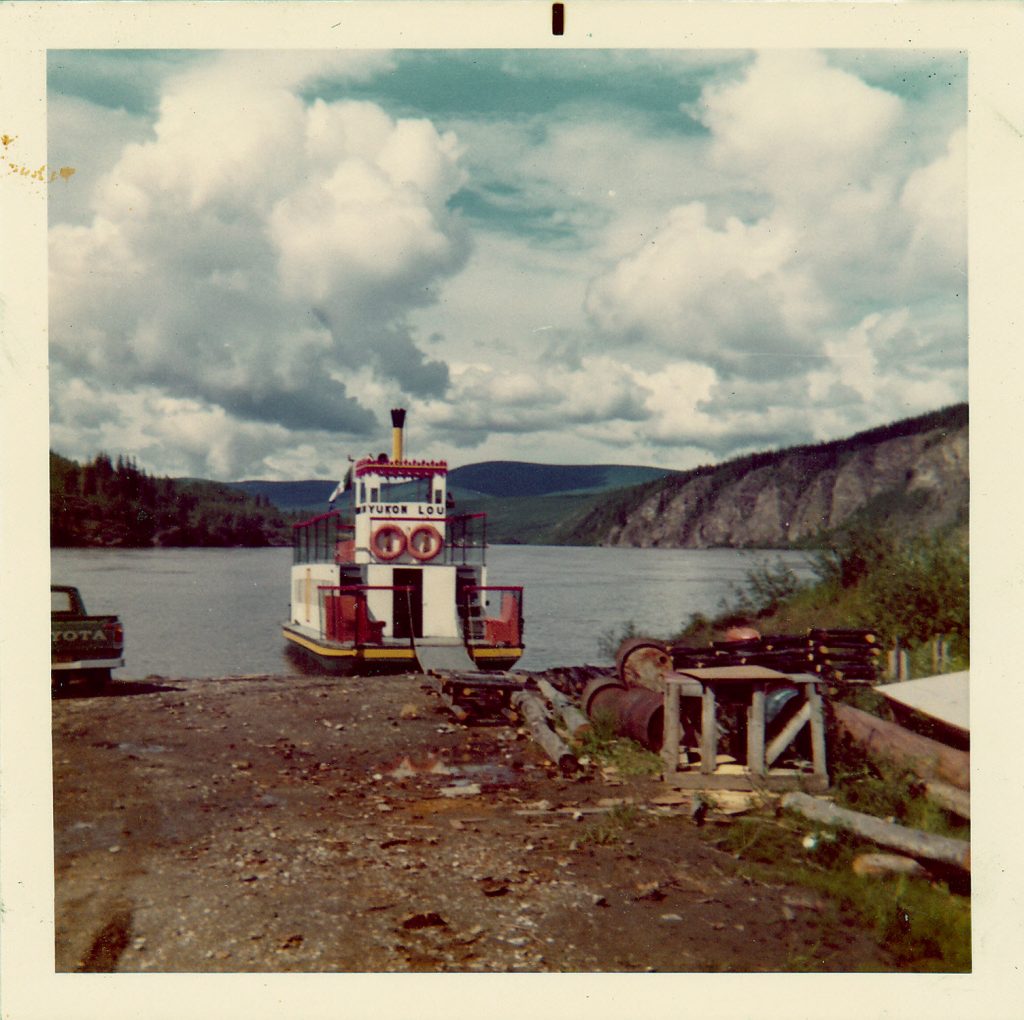
In the weeks that followed, a second job came my way. One day when we were sitting in a café eating breakfast, a fellow dressed in a fringed leather jacket and a captain’s cap came in and sat down at our table. This was Captain Dick Stevenson. He was looking for someone to drive his tour boat, The Yukon Lou and since I had experience driving our motorboat on a lake in Ontario, I got the job. Before every tour, I mopped the floors and cleaned the seats. Then I drove the boat down to the old indigenous village of Moosehide, where The Tr’ondek Hwech’in First nation lived. Captain Dick talked to the tourists with his cat, Captain Cornelius J.C. Flint, perched on his shoulder. This cat only had love for his master and he would scratch and bite if you got too close. As we chugged along, Dick played a little recorded ditty “Yukon Lou, pretty little Lou; you love her when you board her and she’s happy haulin’ you.” The Yukon River moves swiftly and it pushed us at a quick pace downriver to Moosehide. Coming back up to Dawson was another matter as The Lou worked extra hard against the strong current. Thankfully her engine never failed.
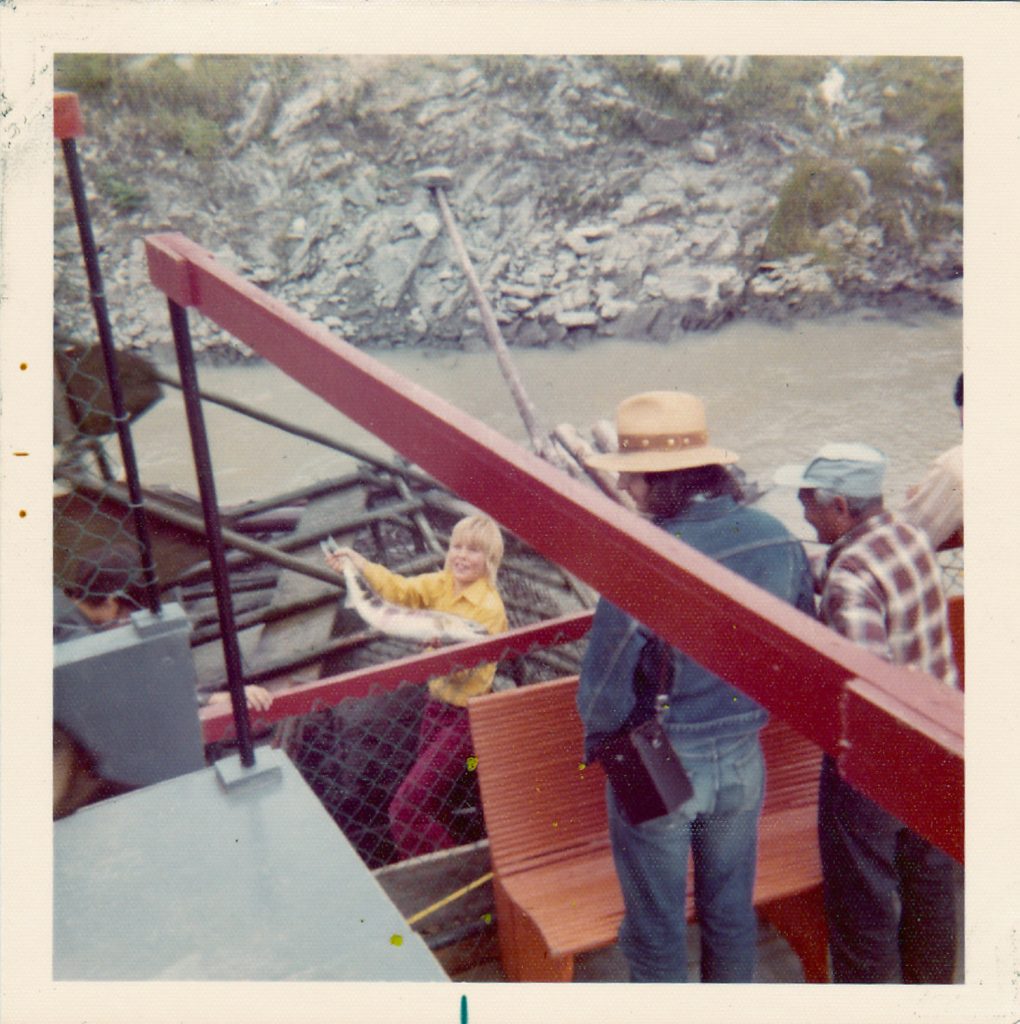
Shortly after I started working for Dick on The Lou, a young boy of thirteen joined our crew. Eric was often mistaken for my little brother since we both had blond hair and other similarities in our looks. So for the summer, this cheerful kid was my little brother. Eric swabbed the decks and when we arrived at Moosehide, he jumped down into the salmon wheel. This device had two wire baskets for scooping fish out of the fast flowing river. Fish dropped into a large wire box and were kept fresh until they were picked up. Eric held up any fish that were caught for the tourists to see. After that, we docked and everyone was allowed to wander over to the old church and walk through the wildflowers. On fine weather days, Moosehide was a lovely picture with the purple fireweed gently blowing in the breeze, the scent of poplar trees on the air. This made a perfect setting for a wedding. On one of the river tours, Dick surprised the tourists by getting married to his sweetheart Lou in the little church.
As I remember it, that was the summer that the sour toe cocktail started. I was sitting at the bar in the Eldorado Hotel with Dick on one of my evenings off work from Gerties. I remember him complaining about a bet he had accepted. He groaned, “Oh Donna, what have I done?! I’ve gone and said that I would drink this glass of champagne with a miner’s toe in it”. I peered into the glass and sure enough, there was an ugly toe in the bottom. It was black from frost bite and the nail was ragged as if it had been sawn off. Little bits of skin were floating to the top of the glass. But Dick wasn’t one to back down from a bet and he tipped that glass back and as he finished the drink, the miner’s toe bumped him on his lip! That was the start of the sour toe cocktail challenge. It became famous internationally and still goes on today although the Downtown Hotel hosts it now. Sometimes the toe is accidentally swallowed and a replacement needs to be found.

In June, four guys from Alaska appeared in town. The year before, they picked up the trail in Dyea, Alaska and hiked over the Chilkoot Pass, felled trees and built a raft at Lake Bennett, then drifted down the Yukon River to Dawson. They were reliving the gold rush days, following one of the routes that many hopefuls took in 1898. That summer they were back to re-build their raft and continue their journey on the Yukon to the Bering Sea. The raft was big enough to carry four men, a canoe, and a cook stove. A huge tent covered four beds made of logs. Two long sweeps on mounts were used to steer the raft. If the going got slow, a sail could be hoisted on a tall mast to catch the wind. The guys made a name for themselves when they held a party for all to attend. In a moment of panic, the raft started sinking and everyone had to adjourn to shore. After that, the guys were known as the River Rats. Their week of fun in Dawson was soon over and they went on their way down the Yukon River. The following year, National Geographic filmed them as they repeated this epic voyage. One of the guys went on to write a book, Yukon Passage.
June also brought the summer solstice when crowds hiked or drove up The Dome. From this vantage point the whole town could be seen as well as the clear Klondike River where it joins the muddy Yukon just south of town. Everybody brought a midnight picnic to welcome the longest day of the year. The sun barely dipped below the horizon and the sky was briefly painted in pastel colours. Being so far north, I was surprised at how warm it got in July. With the sun shining almost twenty four hours, gardens grew quickly. Vegetables seemed twice the size. On a hot mid-summer evening some friends and I went to the Palace Grand theatre. It was fun being entertained instead of being the entertainers. Talented actors brought the gold rush days back to life. This beautiful wooden heritage building was reconstructed in 1962, almost exactly as its’ original from 1899.
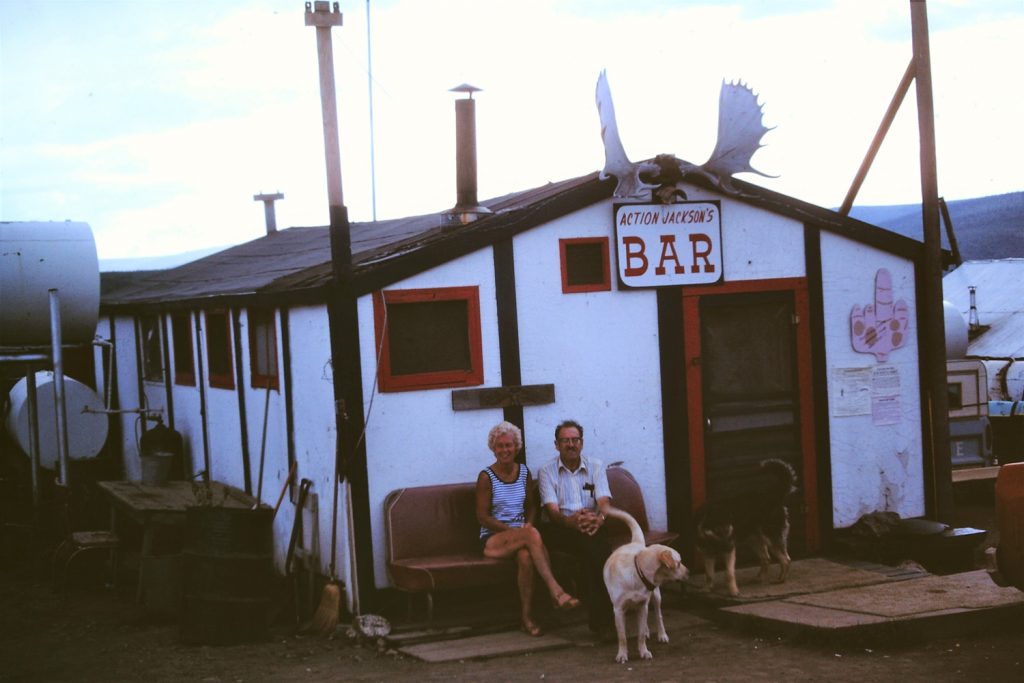
An RCMP celebration was held at Fortymile further on down the Yukon River from Dawson. We hitched a ride on a motorboat and joined the crowd assembled on shore. Fortymile was established in 1886 by prospectors and it is known as the Yukon’s oldest town. Clinton Creek, an asbestos mine, opened here in 1966 and this was where Uri worked for the summer. He stuffed explosives into pre-drilled holes to access the asbestos. Clinton Creek was closed down in 1978. On another trip out of town, my friends and I drove one hundred and seven kilometers to Action Jackson’s. This little white building with red trim was a popular pub at the Canada / U.S. border. Our dollar bills were added to the many others that wallpapered its walls. Cabins were available for those who needed to rest before driving home.
Our pre-planned rendezvous with The River Rats happened near the end of July. They invited three dance hall girls to meet up with them in Tanana, Alaska. When our performance at Gerties was finished for the night, we drove back to Action Jackson’s but this time it was to catch an early morning flight. A four seater bush plane that carried mail into Alaska was also carrying us, as far as Fairbanks. Our flight became exciting when we were caught in a thunder and lightning storm and had to land in Eagle until the weather cleared. Then we continued on our way to Fairbanks and from there we caught another flight to the little village of Tanana. This is where the Tanana River flows into the Yukon. Tanana was used by different indigenous groups as a trading and meeting place. We spent five days picking berries and swimming in the river. It was a relaxing, pleasant time away from our busy lives in Dawson. But it all ended quickly. We had to get back to our jobs and the guys had to get on their way down the Yukon River. They still had a long way to go to where they would build a cabin for the winter and end their trip at the Bering Sea. The Yukon is not an easy river to navigate, especially on a raft. There are under tows, whirl pools, rapids, and snags to maneuver through. Snags are bunched up fallen trees and branches that get stuck along the shore and can tear apart a boat or raft if you got too close to one.
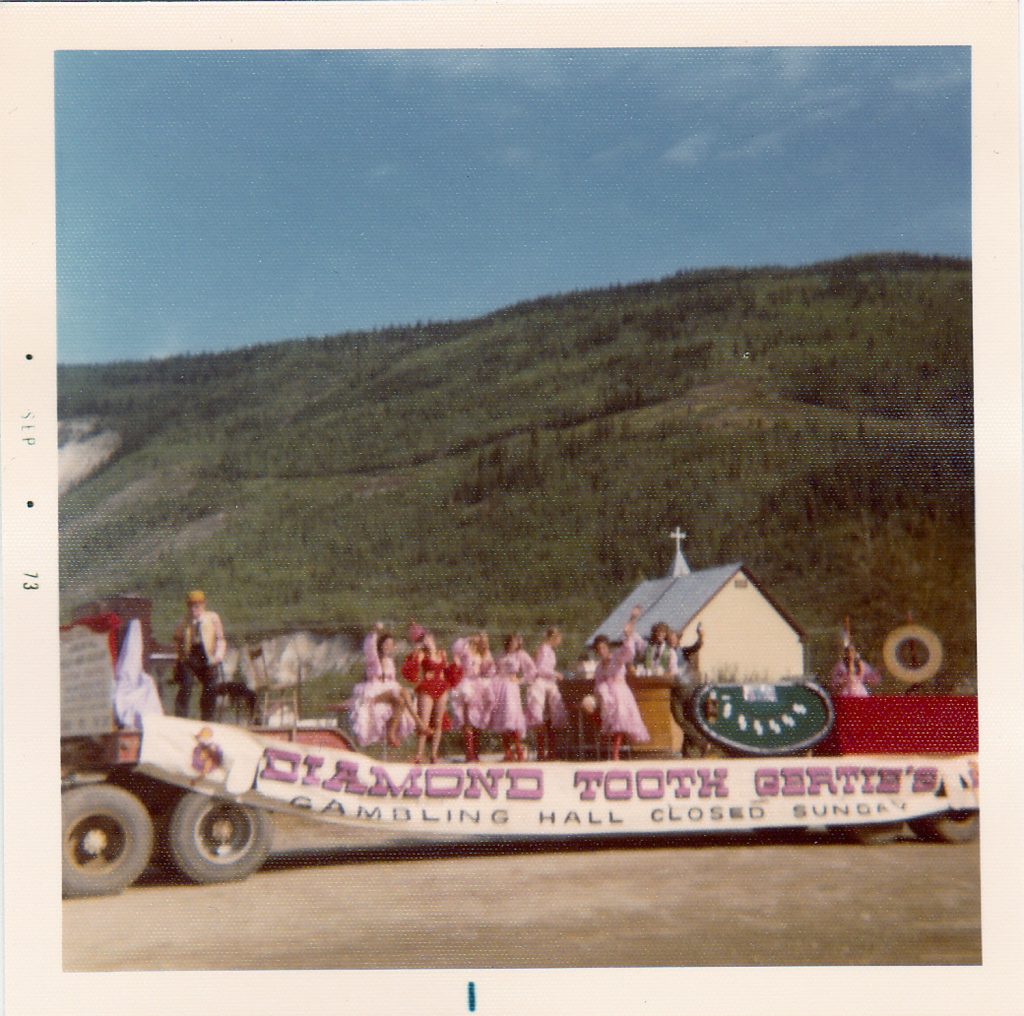
When we got back to Dawson, it was already the first week of August. Dawson City has a Discovery Day parade every August 17th to commemorate the discovery of gold. That year we made a catching display on the Diamond Tooth Gerties float. We ruffled our skirts for the cancan, with Joyce singing, dressed in her daring red feather costume, and Fred playing the piano in our midst. In the last week of August we were mesmerized by the magic of the aurora borealis as darkness returned to the northern skies. Swirls of pale green, white, and sometimes crimson danced and twisted above the hills on our way home from Gerties. The sky became alive as lights pulsed to their own heartbeat. I remember reading Robert Service all night beside the river, bewitched by poetry and the performance above us.
Summer was drawing to an end. Everybody who wasn’t staying in Dawson for the winter was leaving. As we packed up our belongings, I felt sad to say goodbye to our little white cabin and my life in the Yukon. We were leaving with a different kind of gold. I recalled Laura Berton’s book I Married The Klondike when she said just how significant the last boat leaving Dawson in the fall was. Some people never came back, so the last boat was a melancholy affair. Friendships from that summer followed me into the next year. When I visited Vancouver, I looked up Uri and I’m glad I did. We fell in love and married a few years later. Four fantastic children followed. I connected with my “little brother” Eric forty-seven years later as we reminisced about those Dawson days. Things like this make life rich!
Uri and I long for our next northern adventure, to replenish our golden memories and to sip from the Sour Toe Cocktail. Thankfully the Klondike highway is now paved! Some things will be the same. People still bet on when the ice will break up on the Yukon River. Diamond Tooth Gerties is in full swing with professional dancers and many more gambling opportunities. The Dome continues to be a destination on June 21st for midnight picnics. Discovery Day celebrations offer a wide range of festivities now.
The Yukon is casting its’ spell upon us once again and as Robert Service said,
“There’s a land-oh, it beckons and beckons, And I want to go back and I will.”
The end.
View the complete photo album here:
